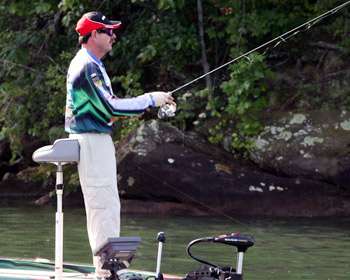
Long before the flipping tube was a staple of shallow water, heavy cover fishing, and well in advance of the average angler learning about dragging tubes across the Great Lakes, Shaw Grigsby was using these mini-squids to take other anglers' entry fees.
"The tube bait is a versatile bait," he says. "It looks just like a shad, and they eat a lot of shad. It also looks like a crawfish when it's on the bottom, so you have both baits in one lure. You're appealing to everything that the bass normally eats."
It's particularly deadly when he can see the fish he's targeting, but capitalizing on those bass is part art, part science.
"If you're going along and you see them, you don't just want to cast it on their head," he said. "There's something about a tube bait that is exceptional. When you rig it with an exposed hook and a jig head, it skips like a son of a gun. It's like a shad that's scared of another bass trying to eat it. And one thing we know that's a fact about bass is that they're extremely competitive. They don't live by sitting back and waiting on something. They're ambush feeders, but they're extremely competitive," explains Grigsby.
"A baitfish that another fish eats is one that they don't get. How many times have you hooked a bass and there are two or three with it trying to get the bait out of its mouth? If one bass looks at your lure and the other sees that, they're all going to go for it. So if you skip cast to them, a lot of times they eat it off the surface."
He said that a standard shaky head jighead is perfect for skipping, and "once it hits the water it spirals down. Instead of diving straight, it'll spiral like a dying shad falling down — an easy meal. That gets their opportunistic instincts going." Depending on the depth of the fish he's targeting, he'll usually use a head that weighs somewhere between 1/8 and 1/4 ounce.
But just because the bass doesn't eat the tube on the way down doesn't mean it's time to reel in the lure and cast again. Grigsby has developed a system that depends on provoking the fish's curiosity. But he cautions that most anglers don't retrieve the tube properly.
"Once it's on the bottom, he's looking. It's kind of like a crawfish, with the little legs and the skirt is like the pinchers, so most people want to hop it. But that's not really what a crawfish looks like. We've seen them in a creek. They blend in tremendously in the rocks, they're camouflaged. They won't really move until you spook them. So that's not the natural movement of a crawfish, to be hopping around. You just slowly drag it, a quarter-inch at a time, so it's just like a crawfish sneaking out of a rock. They usually pound it right there. That's my best technique. If I do that and he won't eat it, then I'll hop it. That's my last-ditch effort."
He believes that the tube is particularly deadly in clear water. After all, he's seen fish come from as far away as 60 feet to make it a meal. But they don't rush willy-nilly into anything.
"They'll just ease after it, they don't need to blister after it because they can see it," he says. "The bait has to look natural. That's why the good crawfish or shad color is so important."
He also depends on skills more familiar to shotgunners than to many bass fishermen in making his cast, leading the fish by a set amount.
"When you see a fish moving, my best lead is probably about 10 feet," he advises. "Hitting them close will spook them a lot of times. I had one 7-pounder at Okeechobee; I led her and she would just swim right over it. I was all pumped up — I had a limit — but she ignored it. I thought maybe she didn't see it. This time I cut my lead down to about 5 feet, and she was about to get out of the pocket where I couldn't see her. The third time, when the tube sank down, a bluegill just smacked it, and picked it up by the tentacles on the back. That 7-pounder saw that and wasn't going to let the bluegill have anything edible. She went over there and the bluegill spit it out and hauled butt. She ate it and I caught her."
He throws the tube on spinning tackle, usually with 8- or 10- pound test fluorocarbon line.
"I'm using a 6-foot, 10-inch Quantum Shaw Grigsby Signature Series rod (Model No. PTS6105FSG) that I designed specifically for skipping and casting tube baits at sight fish," he says. "It's tremendous for worm fishing too. It's kind of a medium-heavy, so it has a lot of power in it, and it's got a parabolic bend which makes it easy to cast but it won't pull the hook out of the fish's mouth. Once you stick him, it'll hold him."
So in a world full of complex soft plastics, with every conceivable sort of leg, tail and appendage available in some combination, anglers who relegate the simple tube to the bottom of their tackle boxes are missing out. Go back to the simple things and you'll cash in big time.
(Provided exclusively to BASS Insider by Z3 Media)





